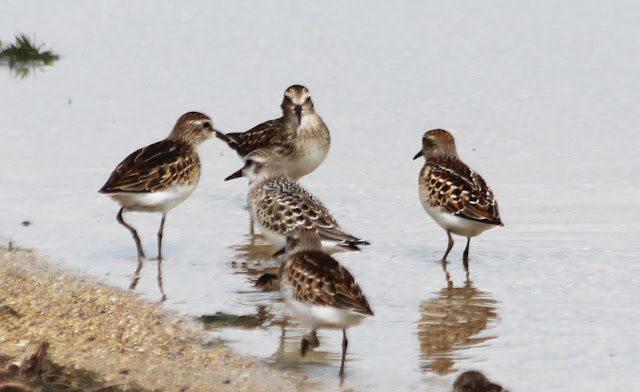Least Sandpiper
| Erolia minutilla |
This species has greenish legs and a short thin dark bill. Breeding adults are brown with dark brown streaks on top and white underneath. They have a light line above the eye and a dark crown. In winter, Least Sandpipers are grey above. The juveniles are brightly patterned above with rufous colouration and white mantle stripes.
Their breeding habitat is the northern North American continent on tundra or in bogs. They migrate in flocks to the southern United States and northern South America. They occur as very rare vagrants in western Europe.[3]
These birds forage on mudflats, picking up food by sight, sometimes by probing. They mainly eat small crustaceans, insects and snails. (Wikipedia)
Once again I was at Bong which is rapidly becoming a favorite haunt because I seem to see something new every time I go (I know that luck probably has limits, but I am going to enjoy it while I can). There is a small lake with a beach that we wondered down to and to our surprise we spotted this small group of Least Sandpipers. I had to walk past them in order to get the light right for pictures and I was afraid they would fly away ... but, as you see, they were not the "least" concerned about me.
Just beyond where the Least Sandpipers were I noticed a lone bird working his way through a weedy area of the lake, so I took a few pictures. At first I thought it was on of the Least Sandpipers who had wondered off, but I was wrong ...
Solitary Sandpiper
the Solitary Sandpiper is usually seen singly as it migrates through the state, shunning the more gregarious nature of most other sandpipers. Also unlike nearly all other sandpipers, they don't nest on the ground, but instead use old songbird nests in trees. Solitary Sandpipers sometimes practice nest parasitism, laying their eggs in the nests of different species of birds.
We saw many other birds this day, some I have posted already and others that are yet to come. It was a great day for a Birder/photography fanatic.
Hope your day is full of sunshine :)










.jpg)


14 comments:
Wonderful shots of both the Sandpipers, great post and photos.
I really enjoyed your Sandpiper pictures. I haven't see these types yet. From Findlay
I love, love, LOVE to watch these sandpipers scurring along the surf, and then to rush back to dry land...only to scurry back out again with the ebb.
Great photos.
A great serie of photos!
Great shots. I really love wading birds and especially sandpipers. Really nice to see.
Great photos. Those are both shorebirds that I would love to see.
I have just this year learned about the least sandpipers. Lovely shots of them, Andrea.
How wonderful to see the Least and the Solitary on the one day. I think I would be haunting that spot...
Lovely, lovely series. Thank you.
Wonderful series!
I love the reflections.
Wonderful photographs, I like to admire such views. I am greeting
Great set of pictures - the waders are staring to show up down here now - summer is the peak time for them, and I try to get out to band (ring) some of the flocks - if you ever get the chance you should get involved.
My flamingos are Greater's - its the Lesser that are the bright pink birds. (but I only knew this after I looked it up!) Also I pretty sure mine "close up" bird is a juvenile which means its still very grey. What ever else you can say, they are strange looking birds!
Thanks for linking to WBW.
Stewart M - AUstralia
Andrea...Loved your sandpipers! You are a good photographer!
Thanks for your kind remarks and comments on my blog post!
Have a great day!
Linda
Nice captures of these lovely shorebirds.
Fabulous Sandpiper shots. here's another bird I have not seen up close and personal. I'm really enjoying your bird photos. Have a great weekend, hugs, Edna B.
Post a Comment